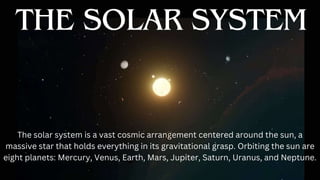
The solar system (consists of all planets).pptx
- 1. THE SOLAR SYSTEM The solar system is a vast cosmic arrangement centered around the sun, a massive star that holds everything in its gravitational grasp. Orbiting the sun are eight planets: Mercury, Venus, Earth, Mars, Jupiter, Saturn, Uranus, and Neptune.
- 2. SUN
- 3. The sun is the star at the center of our solar system, around which the Earth and other planets orbit. It is a nearly perfect sphere of hot plasma, primarily composed of hydrogen and helium. The sun's immense gravity generates nuclear fusion reactions at its core, where hydrogen atoms combine to form helium, releasing a tremendous amount of energy in the process. This energy radiates outward, providing heat and light to the planets and bodies within the solar system. The sun plays a crucial role in sustaining life on Earth, providing the energy necessary for photosynthesis and driving weather patterns. It is estimated to be about 4.6 billion years old and is expected to continue its life cycle for several billion more years.
- 4. MERCURY
- 5. Mercury, the smallest planet in our solar system and the closest to the sun, has fascinated astronomers for centuries. Named after the Roman messenger god due to its swift orbit around the sun, Mercury presents a host of intriguing features. Its surface, heavily cratered and resembling that of the moon, bears testimony to the violent impacts it has endured over billions of years. Despite its proximity to the sun, Mercury experiences extreme temperature variations, ranging from blistering heat during the day to freezing cold at night, owing to its lack of atmosphere to regulate heat. This lack of atmosphere also means that Mercury's surface is bombarded by solar radiation and cosmic rays, contributing to its harsh environment.
- 6. VENUS
- 7. Venus, the second planet from the sun, holds a unique place in our solar system. Often referred to as Earth's twin, it shares similar size and composition but possesses an atmosphere that sets it apart dramatically. Venus's thick atmosphere, predominantly composed of carbon dioxide, creates a runaway greenhouse effect, trapping heat and leading to scorching surface temperatures exceeding 450°C (850°F), making it the hottest planet in our solar system. Its surface, shrouded in thick clouds of sulfuric acid, hides a landscape dominated by vast plains, highlands, and thousands of volcanoes, some of which remain active.
- 8. EARTH
- 9. Earth, the third planet from the sun, is a unique and vibrant world, teeming with life and natural wonders. With its diverse landscapes, ranging from towering mountains to sprawling oceans, Earth stands as a beacon of beauty and complexity in our solar system. Its atmosphere, composed primarily of nitrogen and oxygen, provides a protective shield that regulates temperature and sustains life, while its rotation and orbit around the sun dictate the rhythm of days, seasons, and years. Home to a rich tapestry of ecosystems, Earth hosts an astonishing array of biodiversity, from the depths of the oceans to the heights of the skies.
- 10. MARS
- 11. Mars, the fourth planet from the sun, has been a subject of fascination for centuries, captivating both scientists and dreamers alike. Its distinctive reddish hue is due to iron oxide, or rust, covering much of its surface. Mars has a thin atmosphere primarily composed of carbon dioxide, and its surface features include vast deserts, ancient river valleys, and towering volcanoes. The planet's polar ice caps consist of water and carbon dioxide ice. Over the years, numerous robotic missions, including orbiters, landers, and rovers, have ventured to Mars to study its geology, climate, and potential for past or present life. Recent discoveries, such as evidence of ancient lakes and river channels, have bolstered the notion that Mars was once a much wetter and possibly habitable world.
- 12. JUPITER
- 13. JUPITER, THE LARGEST PLANET IN OUR SOLAR SYSTEM, STANDS AS A COLOSSAL GAS GIANT DOMINATING THE CELESTIAL STAGE. ITS IMMENSE SIZE, MORE THAN 11 TIMES WIDER THAN EARTH, IS MATCHED BY ITS STRIKING APPEARANCE CHARACTERIZED BY SWIRLING BANDS OF CLOUDS AND THE ICONIC GREAT RED SPOT, A COLOSSAL STORM SYSTEM. COMPOSED PRIMARILY OF HYDROGEN AND HELIUM, JUPITER'S ATMOSPHERE HOLDS A TREASURE TROVE OF MYSTERIES, INCLUDING ITS POWERFUL MAGNETIC FIELD, WHICH CREATES INTENSE RADIATION BELTS.
- 14. SATURN
- 15. SATURN, THE SIXTH PLANET FROM THE SUN, IS RENOWNED FOR ITS CAPTIVATING BEAUTY AND UNIQUE FEATURES THAT SET IT APART IN OUR SOLAR SYSTEM. WITH ITS MAJESTIC RINGS ENCIRCLING THE PLANET, SATURN PRESENTS A STUNNING SPECTACLE VISIBLE EVEN FROM TELESCOPES ON EARTH. THESE RINGS, COMPOSED OF COUNTLESS ICY PARTICLES RANGING IN SIZE, ADD TO SATURN'S ALLURE AND HAVE INTRIGUED ASTRONOMERS SINCE THEIR DISCOVERY BY GALILEO IN 1610. BEYOND ITS RINGS, SATURN BOASTS A RICH ATMOSPHERE PRIMARILY COMPOSED OF HYDROGEN AND HELIUM, ADORNED WITH SWIRLING CLOUD BANDS AND POWERFUL STORMS.
- 16. URANUS
- 17. Uranus, the seventh planet from the sun, is a fascinating and enigmatic world in our solar system. It stands out for its distinct characteristics, including its unusual rotational axis, which is nearly perpendicular to its orbital plane, causing it to appear to roll on its side as it orbits the sun. This unique tilt results in extreme seasonal variations on Uranus, with each pole experiencing 42 years of continuous sunlight followed by 42 years of darkness during its 84-year orbit.
- 18. NEPTUNE Neptune, the eighth and outermost planet in our solar system, a distant and mysterious world that holds many secrets waitin to be discovered. It orbits the sun at an average distance of about 4.5 billion kilometers (2.8 billion miles) and completes on orbit roughly every 165 Earth years. With a diameter of about 49,244 kilometers (30,598 miles), Neptune is the fourth-larges planet in our solar system. Its atmosphere, primarily compose of hydrogen, helium, and methane, gives it its striking blue coloration, reminiscent of the deep ocean.
- 19. HOPE, YOU ALL LEARNED AND UNDERSTOOD